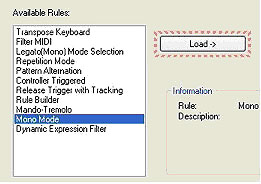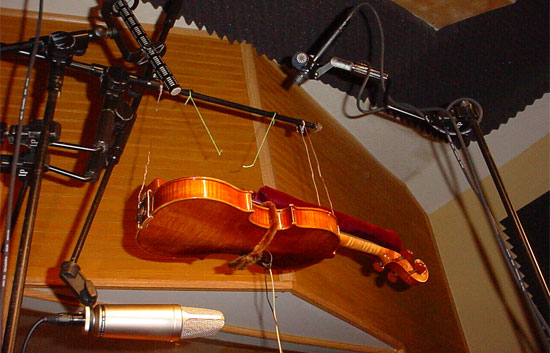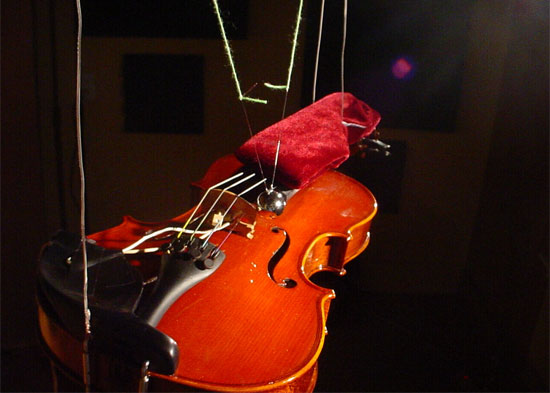GIGAVIOLIN APPLICATIONS
GigaViolin Body Model

The GigaViolin Instrument Models come in a few variations: Anechoic, Normal, Vintage, and Multi-Mic. These variations were created using alternate microphone types and techniques as well as additional empirical processing in order to create a wide variance in sound and application.
Anechoic - The "Anechoic" body models favor the Back and Belly Mic positions which were placed approximately 1/8th of and inch from the Violin during the Impulse recording session. The resulting impulse has an exaggerated closeness with very little room ambience.
Normal - The "Normal" body models favor the Overhead Stereo Mic positions, which were placed approximately 4 feet above the Violin during the Impulse recording session. Because of the distance between the violin and microphones, the resulting impulse response has a natural room ambience similar to a typical studio recording of a solo violin.
Vintage - The "Vintage" body models were created using the Overhead Mic positions coupled with Finite Impulse Response Filtering. The FIR Filtering was used to model vintage recordings of solo violin performances.
Multi-Mic - The "Multi-Mic" body models were created using an empirical sub-mix of all six mic positions. The resulting impulse sounds like a combination of the Anechoic and Normal models with unique harmonic overtones.
GigaStudio V3.1 DEF and PRF Filter Technology

The DEF and PRF filter technologies are new to GigaStudio V3.1 and consist of two new phase corrected, 7th order morphing filters designed to increase the overall expressiveness and realism of sampled instruments, while at the same time increasing performance and sonic integrity.
DEF - Dynamic Expression Filter
The DEF filter provides a continuous, note-specific, morphing filter for adding expressiveness before and after sustaining note-on events. Using a traditional MIDI controller, the user can accurately and continuously morph the frequency response of sustaining samples between velocity dynamics, even after note-on events have occurred.
What this means for GigaViolin users is the ability to perform phase accurate real-time crescendos and decrescendos using a single sustaining note, effectively replacing the need for layered X-fade instruments that increase polyphony and introduce phase inaccuracies. The result is a more lyrical and "live" sounding instrument that gives the user expanded depth of control over musical phrasing and dynamic range.
 PRF - Portamento Reshaping Filter (Gliss)
PRF - Portamento Reshaping Filter (Gliss)
The PRF filter provides a phase corrected, 7th order, morphing filter for shaping formants dynamically as the pitch of a sample is transposed over time. With appropriate custom PRF filter profiles created by the instrument developer, this filter can continuously morph the frequency response of a sample as it is stretched beyond its original pitch for ascending and descending transpositions.
The morphing response can be different for every note and every note interval both ascending and descending from the root note. Custom filter coefficient banks are created for the PRF and built into instruments by the instrument designer using a Mono mode iMIDI rule.
By dynamically de-emphasizing formant shifts resulting from sample transposition, the PRF Filter technology gives GigaViolin users the ability to create tempo independent glissandos between two notes. After assigning a controller to MIDI Portamento Time (CC#5), it is possible to create glissandos ranging from a few seconds to a few milliseconds, depending on the tempo and feel of the music.
GigaViolin instruments that employ the Portamento Reshaping Filter contain the word "Gliss" in their instrument name. For detailed instructions on how to change Portamento time please see the tutorial titled "Varying Portamento time using a MIDI Continuous Controller".
GigaViolin Live Performance System

In addition to being a comprehensive solo violin sample library, GigaViolin is also a live performance system that presents entirely new possibilities for the performing violinist...
In order to use GigaStudio and GigaViolin as a live performance system, you must have installed an audio interface with GSIF2 compatibility. The GSIF2 kernel-level audio engine allows you to record or process a live violin input in real time with the lowest possible latency by simply assigning selecting a hardware input as the source for a DSP Station channel that contains the inserted instance of GigaViolin.
Combining GigaViolin with Live Performance:
-
The samples in the GigaViolin Library were recorded using an inexpensive Electric Violin since the sound of GigaViolin is dynamically created by the GigaPulse convolution processing. The nature of an electric violin is that its direct signal is "bodyless".
It is possible to use GigaViolin as a live performance system using any electric violin; however, any given electric violin will have its own unique timbral character.
The GigaViolin Modeling Process

All of GigaViolin's body models were recorded in an identical fashion using a series of six microphones ranging in distance from 1/8th of an inch to four feet from the instrument. The placement of each microphone captured a unique pattern of the violin's acoustic radiation. Using GigaPulse, the output of each microphone can then be adjusted by the user to achieve a desired timbre and perceived distance.
Precise tuning of the strings was maintained throughout the modeling process. To capture the impulse the violin was excited by carefully striking the bridge with an impulse hammer. The violin's response to the hammer was recorded simultaneously with all six microphones. Once a set of impulse responses had been captured and edited, additional empirical modifications were made in order to optimize the timbre and phase coherence of each set.

The above image is an illustration of the frequency response of the exact impulse hammer used to create the GigaViolin body models.

Microphone Position and Type:
| Overhead Pair | - AT4051 (matched pair) - Overall Full-Body resonance |
| Top | - K6/ME67 (Sennheiser Long Shotgun) - Localized f-hole resonance |
| Bottom | - Rode NT1000 - Localized lower back position |
| Back | - Sure WL93T (omni lavalier) - Localized back surface resonance |
| Belly [Top Plate] | - Sure WL93T (omni lavalier) - Localized top plate surface resonance |
samples are convolved with acoustic violin body models to create a dynamic and rich sounding instrument that is radically customizable.
Choose your instrument, choose your performance style, and choose your performance space...


